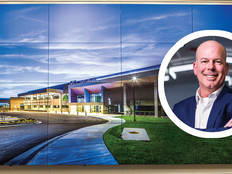In the past, one measure of success for one-to-one computing programs in K–12 schools was simply getting devices into students’ hands so they could access the internet and other digital resources. Today, one-to-one programs are common, and success now encompasses getting devices into students’ hands and keeping them operational.
Most one-to-one programs are built around a four-year cycle (the expected service life of a K–12 laptop), with new, refreshed devices introduced at intervals during that cycle to replace a portion of the fleet. For K–12 IT staff, the challenge is how to maintain devices in and out of warranty so they remain functional throughout that four-year time frame.
“We now have more devices in circulation, increasing break rates, and schools have fewer staff members available to meet those repair needs,” explains Derek Carnwath, device lifecycle manager at CDW.
Click the banner to learn how partners can help improve the management of your device ecosystem.
What Are Break/Fix Services in K–12 Schools?
How can schools manage the upkeep of their device fleets in this challenging environment? This is where break/fix programs come in. These programs keep devices in top shape and in students’ hands so they can focus on learning. Schools have two options for their break/fix programs: They can make repairs in-house, or they can use a maintenance service provider.
How Self-Repair Break/Fix Programs Work in Schools
Since the 2016 start of its one-to-one program, the Beaverton (Ore.) School District has been doing its own repair work on student devices. “We already had staff that were repairing devices piecemeal,” explains BSD CIO Steve Langford. “We created a tiered system, with our tech support specialists trained to handle simple repairs right at the school and do more advanced repairs centrally in the district office.”
With a fleet of more than 65,000 devices, the district maintains strong relationships with device manufacturers. It leverages those relationships for easy access to device parts — essential for a successful self-repair break/fix program. Some in-warranty repair work done by BSD technicians earns credit toward future device purchases.
RELATED: Schools proactively plan to replace aging tech assets ahead of the federal funding cliff.
Langford cites efficiency as one of the drivers for BSD’s investment in its self-repair program. That sentiment is echoed by Don Ringelestein, executive director of technology at Yorkville (Ill.) Community Unit School District 115. “The primary value of our break/fix program is its quick turnaround time,” Ringelestein says. “When we take devices aside for repairs, we have loaner devices we give to students so they don’t experience downtime and can keep their focus on learning.”
Self-Repair Break/Fix Programs Deliver Budgetary Value
Yorkville’s in-school technicians have additional responsibilities beyond device repair, which helps drive greater budgetary value. “We decided to go the self-repair route because the cost made more sense for us,” explains Ringelestein. “Since the technicians serve more than one function, beyond working on staff and student devices, they help us make effective use of our budget.”
Langford agrees, sharing that BSD trains its technology staff to do a broad range of device repairs. “A couple of years ago, our technicians began doing motherboard repairs,” says Langford. “It’s always the same chips or ports that fail, and that’s easy to fix once the staff is trained in soldering. We started tracking costs, and at this point we’ve saved about $150,000 over 18 months.”
Both BSD and Yorkville also stress the value of getting students involved in their in-house break fix programs. “At the high school level, we have students already interested in working on devices,” says Langford. “This helps us build additional repair capacity while also helping students develop skills.”
Ringelestein says Yorkville has student interns who work on devices over the summer. “It gives students a better appreciation for taking care of devices, and it gives them a leg up in their post-high school education and job pursuits,” he says.
READ MORE: West Philadelphia students learn valuable skills repairing Chromebooks.
How Do Managed Break/Fix Services Work?
Managing all of the moving parts of an in-house repair program is not for every district. Taking a turnkey approach and hiring a maintenance service provider can greatly simplify the task of keeping devices available to students. Some districts pay only for the amount of the service they use, so break/fix can be affordable in the short term. Service options vary, with some vendors offering more robust support options than others.
“By having clearly defined repair procedures, quality control standards and a ready supply of parts on hand, we can eliminate many of the challenges that self-maintainers face,” says Josh King, CEO of Lexicon Technologies, a maintenance service provider. “This also frees up district employees to pursue the best use of their time in student- and educator-facing work.”
A service provider can also deliver additional benefits that would be beyond the reach of most self-repair programs, such as device fleet insights culled from working with a larger pool of districts. “The benefits can range from identifying unknown shortcomings in your device management strategy to uncovering critical insights into your fleet’s performance from the real-time analytics we capture,” King explains. “It helps to have an informed and experienced advocate when you encounter a factory defect that should be covered under the manufacturer’s warranty.”
DIG DEEPER: Strong lifecycle management plans support one-to-one success.
How to Choose the Right Break/Fix Provider for Your School
When comparing maintenance service providers, it’s critical to understand their approach. Are they making repairs themselves, or do they rely on a third party, which could potentially extend repair times?
At Lexicon, “all repairs are performed by in-house technicians,” says King. “We are driven by procedural standards, with a total of 14 individual certifications held by our technicians and engineers.”
In addition, it’s important to know what kind of quality assurance comes with the service. Will the provider fix only ticketed problems, or will they also repair any defects they discover while working on the devices? “We perform a full diagnostic of the device to find and repair all other problems, even ones a district may not have noticed,” says King.
Another question to ask when vetting maintenance service providers: Are they are backed by insurance? Districts need some assurance that the provider will be there for the duration to keep devices in students’ hands. “Many schools are not knowledgeable about whether the warranties are underwritten or insurance-backed,” says CDW’s Carnwath. “A lot of resellers are selling uninsured products. Districts need to understand the risk of not having that underwritten warranty.”
“Insurance underwriting matters because the district can be certain that its funds are protected,” explains King. “Low prices may not be enough to fund its repair obligations, and it will have no insurance underwriter to support them.”
No one likes to read the fine print, but that’s what determines your district’s device support when contracting with a maintenance service provider. Be sure to review the details of the contract with the provider. “A vendor should be able to clearly walk you through how its program works, not just how repairs are done” King says. “What are the limits on coverage? How are they calculated, and are there any additional charges beyond the upfront payment, for things like parts or deductibles? What happens if a repair isn’t covered? You need to protect your investment.”













